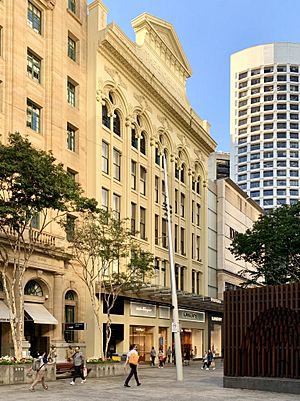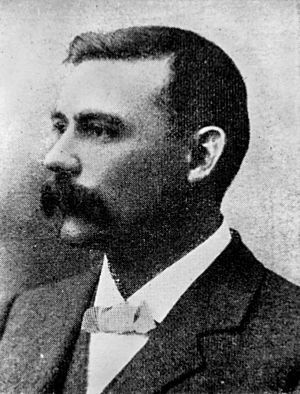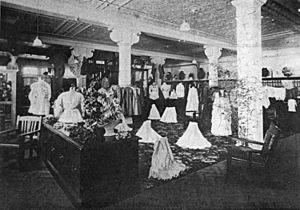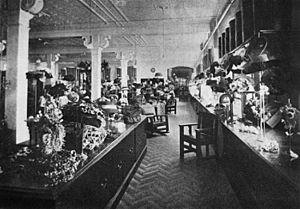- This page was last modified on 17 October 2025, at 10:18. Suggest an edit.
Finney Isles & Co Building facts for kids
| Finney Isles & Co Building | |
|---|---|

Former Finney Isles & Co Building, 2020
|
|
| Location | 196 Queen Street, Brisbane City, City of Brisbane, Queensland, Australia |
| Design period | 1900 - 1914 (early 20th century) |
| Built | 1909 - 1910 |
| Architect | Claude William Chambers |
| Official name: David Jones, Finney Isles & Co | |
| Type | state heritage (built) |
| Designated | 21 October 1992 |
| Reference no. | 600142 |
| Significant period | 1909-1970 (fabric) 1909-1965 (historical) |
| Significant components | tower - water |
| Builders | James Mason |
| Lua error in Module:Location_map at line 420: attempt to index field 'wikibase' (a nil value). | |
The Finney Isles & Co Building is a historic department store located at 196 Queen Street in Brisbane City, Queensland, Australia. It was designed by Claude William Chambers and built between 1909 and 1910 by James Mason. This impressive building was once home to the famous Finney Isles & Co department store.
Later, the building became known as David Jones, another well-known department store. In 1992, it was officially added to the Queensland Heritage Register. This means it's a special place that is protected because of its important history and unique design.
Contents
A Look Back: The Story of Finney Isles & Co Building
This large department store was built in different stages from 1909 to 1936. It was created for the company Finney Isles & Co. This business was started by Thomas Finney and James Isles in 1864. They began with a small clothing store in Fortitude Valley.
Their business quickly grew. By the 1870s, they had moved to Queen Street. In the mid-1880s, they moved to the City Exchange building. Here, they sold a huge variety of items. These included clothes, furniture, and many household goods. Finney Isles also made many of their own products. They had factories that produced both clothing and furniture.
The "Big Block" is Built
The company built a brand new store in 1909-1910. They called it the "Big Block." It was designed by C.W. Chambers, and James Mason was the builder. This building had five floors facing Queen Street. It also had three floors facing Adelaide Street.
This new building was very modern for its time. It was one of the first buildings in Queensland to use reinforced concrete for its structure. The building had special display windows on Queen Street. Inside, there were silky oak staircases and lifts. These lifts were decorated with beautiful latticed ironwork.
The store also had a clever system for handling money. It used pneumatic tubes to send cash around the store. There was a water tower on the roof. A large generator provided electricity for everything. This included the lights, lifts, and the pneumatic system. It even powered the 400 sewing machines in the workrooms!
Growing Bigger
Over the years, the store kept expanding. In 1921, the company bought a two-storey building next door. This building was on the northern side of the Queen Street store. They turned it into the men's department. In 1929, this building was made taller. It became four storeys high. Its outside look was changed to match the 1909 store.
The store grew even more in 1936. A three-storey building was added on the southern side of the Adelaide Street store. This part was designed in the Art Deco style. It had tall, modern columns and decorative panels.
After 1949, more floors were added to the Queen Street building. The Adelaide Street building also grew to five storeys before 1962. An auditorium was built on the fifth floor. This space was used for art shows and dances in the 1930s and during the war years. In 1951, a self-service cafeteria opened inside the store.
In the 1960s, Finney Isles & Co was taken over by David Jones. This meant the building became a David Jones department store.
What the Building Looks Like
The Finney Isles & Co Building has entrances on both Queen Street and Adelaide Street. It is made up of four main parts. Each part has different numbers of floors and different designs on the outside.
Queen Street Side
The southern part of the Queen Street building was built in 1909. It has six floors plus a basement. The front of the building has five tall sections of windows. These sections are separated by thin columns and decorations. At the very top, there are delicate flower designs.
The top edge of the building, called the cornice, is very fancy. It has egg-and-dart patterns and rows of small rose shapes. On the top wall, called the parapet, you can see the words "THE BIG BLOCK" and "FINNEY ISLES & CO. LIMITED" in raised letters. Above this, there's a central triangle shape with the date "A1909D." A walkway made of concrete and glass crosses the Queen Street Mall at the first floor level.
The northern part of the Queen Street building was built in 1929 and extended in 1949. It also has six levels. The front of this section has a metal screen that covers an older design.
Adelaide Street Side
The northern part of the Adelaide Street building was built in 1909. It has three floors. The front of this side is simpler than the Queen Street side. This shows that Adelaide Street was considered less important. The upper windows have wide arched openings. These are connected to the square windows below by plain columns. A central triangle shape at the top includes the date "A 1909 D."
The southern part of the Adelaide Street building was built in 1936. It has six floors. This section is designed in the Art Deco style. It has three sections of four windows. These are separated by tall, flat columns. There are decorative bands between the columns at each floor level.
Today, the shopfronts on both Queen Street and Adelaide Street have modern windows and fittings. Inside, the store has been changed a lot over the years. However, some parts of the original ceilings can still be seen. The 1930s Adelaide Street section still has many of its Art Deco details. You can see black and white Rockhampton marble around the lifts.
Why This Building is Special
The Finney Isles & Co Building was added to the Queensland Heritage Register on 21 October 1992. It's considered important for a few reasons:
- It shows what a big department store looked like in the early 1900s. It's a great example of how these stores were built. It also fits well with other old buildings nearby, like the National Australia Bank.
- It's a beautiful building. People value its design, especially the detailed front on Queen Street from 1909. The Art Deco design from 1936 on the Adelaide Street side is also very striking. It adds a lot to the look of both Queen and Adelaide streets.
- It's connected to important people and a famous company. The building has a special link to Thomas Finney and James Isles. Their company, Finney Isles & Co, was a very important department store in Queensland's history.






